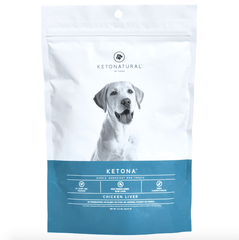Save Money, Save Your Dog.
Join Our Email List For Discounted Pricing and a Free Guide to the Science of Keto Dog Food.
Obesity kills dogs.
It’s that simple, really. We can spend our time discussing the specific health conditions that have been linked with obesity – nasty stuff like diabetes, heart disease, and cancer. Or we can focus on figuring out how obesity does it’s dirty business – explaining the specific biological processes going on inside an obese body. But the bottom line is this: all else being equal, an overweight dog is likely to die about 1.8 years earlier than a lean dog. In terms of “actionable knowledge,” that’s really all we need to know.
So what’s a loving dog owner who just wants his or her dog to live a long, full life to do about it? How do you put that knowledge to work?
You take three simple steps:
The first step is admitting that your dog could have a problem. You don’t have to form conclusions or wed yourself to a position, just open your mind to the possibility that your preconceived notions about the appropriateness of your dog’s weight could be wrong.
This isn’t as easy as it sounds. It will require that you overcome your natural tendency to deny that there’s anything “wrong” with your dog. This tendency will be exacerbated by the inescapable conclusion that you, as your dog’s guardian and caretaker, are responsible for shaping the animal’s lifestyle. Many people are not honest and caring enough to look at themselves with the kind of critical perspective necessary to make that sort of an admission (it’s no real surprise that canine obesity is wildly under-diagnosed). But you can do it – remember, you’re going through this unpleasantness because you love your dog and you want her to live as long and healthy a life as possible. It’s worth it.
The second step is figuring out whether your dog does have a problem. If you’ve completed step one, then this one will be a piece of cake. Just use one of the several scientifically-proven methods for determining whether your dog is overweight. They’re designed to be quick and easy, they require no special equipment, and they can all be performed from the comfort of your living room. Best of all, they’ve been proven to be accurate and effective, so, in a matter of minutes, you can have an objective analysis of your dog’s body composition.
If the results show that your dog isn’t overweight then you’re in luck (and in the minority) – you can skip step three. Just keep doing whatever you’re doing. Thanks for reading.
If, on the other hand, your cold, un-emotional analysis reveals that your dog is overweight or obese, then you need to take an important third and final step.
That third step, of course, is doing something about the problem. Canine obesity is a puzzle that can be effectively attacked from all sorts of angles, from simple dietary changes to improved exercise habits. Our regular readers will know that we use this blog as a platform from which to highlight some of the most interesting, effective, and note-worthy ones (along with publishing other canine fitness and wellness content). Keep up with us and we’ll give you an assortment of ways to solve the obesity problem, leaving you free to chose the solution that fits best with your lifestyle.
Just three simple steps. If you want your dog to live a long and healthy life, it’s really that easy.


Related Articles
How Much Does The Farmer’s Dog Really Cost?
5 Signs and Symptoms That Your Dog May Have Diabetes
Learning to Take Pleasure In Being Your Dog's Play Buddy-Drill Sargeant
Dogs, Dog Food and Dogma - A Book About America's Pet Obesity Epidemic
Browse Articles By Category